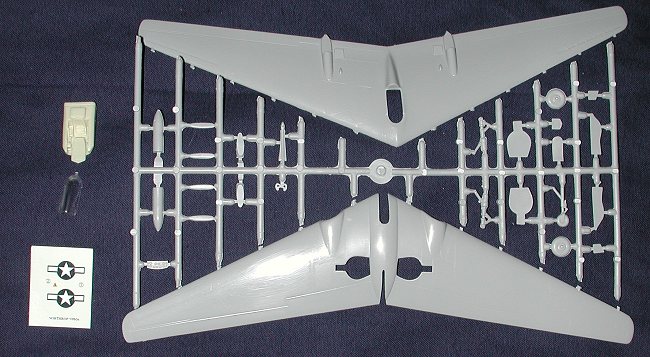
|
KIT: |
Sword 1/72 N9MA Flying Wing |
|
KIT # |
72001 |
|
PRICE: |
$17.98 |
|
DECALS: |
One aircraft |
|
REVIEW & |
|
|
NOTES: |
|

|
HISTORY |
I don't know about you, but I like flying wings. Every book I have found on the subject I have bought and read. To me, they just look cool. They are also about as basic a flying machine as you can find. Perhaps that is what is so intriguing about them. During the mid-30s and on through WWII, there were two groups of people, one in the US and one in Germany, that were working on flying wings. In Germany, the Horton Brothers were working on their all wing aircraft, albeit with little real success in terms of production contracts. Their efforts culminated in the Ho-229 twin jet-engined wing fighter that was flown in the last months of the war. Most of their work was done on their own without any official sanctions until near the end of the war.
In the US, Jack Northrop was also working on all wing aircraft. Unlike the Hortons, Northrop worked within the industry and had produced successful 'normal' aircraft, including the superb P-61 Black Widow. However, he was always tinkering with his wings. With the US to be inevitably drawn into the war, the USAAF was looking for a very long range bomber. The wing seemed like the best way to do this so Northrop was tasked to develop what became the XB-35 bomber. Neither group was aware of the others existence, yet both came to very similar conclusions.
Developing such a plane was not easy as most of it needed technology that was either untried or not yet invented. These things had to be developed by his engineering staff. To say that the development of the B-35 and subsequent wing aircraft was protracted would be grossly understating the problems that had to be overcome. The best way to determine the soundness of Northrop's aerodynamic design would be to build a smaller aircraft. What we now call a 'technology demonstrator'. These smaller aircraft are the N9Ms.
These small aircraft held one man and were powered by twin Menasco air-cooled engines, each driving a wooden two bladed prop. These aircraft were 1/9 scale to the proposed B-35, hence the 9 in N9M. A total of four were built, the fourth to replace one that crashed. The aircraft were very easy to fly and handled superbly. All but one of them later succumbed to time and operation. There is an earlier Northrop wing in the NASM collection. Another was built from scratch a few years ago by the Planes of Fame museum in California and is in flying status.
|
THE KIT |

Other than the huge AMT 1/72 XB-35 and YB-49, this is the only other injected Northrop wing kit in 1/72. It is typical of Czech short run kits with semi-soft plastic, engraved panel lines and relatively large sprue gates. In order to get the kit to fit into a standard Sword box, the upper and lower wings were cut from the sprue. This results in some rather jagged edges that had cut the polybag to shreds by the time I got the kit. Fortunately, it seems as if all the bits were still there.
The kit has a very nice resin interior, a feature that I appreciate as often these short run kits have rather bland interiors. It also has separate prop blades and no real dedicated spinner; the blades being glued onto the combination spinner/engine extension tube housing. While there is little flash on the kit, the mold seam is rather prominent on several of the pieces, requiring careful cleanup. The canopy is one piece and is in injected plastic (thank you).
Instructions are adequate enough, especially considering that there are not that many parts to the kit. Basic color info is given in the four step construction sequence. The N9MA has two possible color schemes. One with trainer yellow on the uppersurfaces and trainer blue undersurfaces. The other has the two colors reversed. Decals are limited to stars and bars. No serial number was ever carried on these smaller wings. They were considered test objects and not aircraft. All were flown by civilian pilots, for the most part.
The kit looks like it will make into a very nice model. It is simple enough for this to be a great kit for an introduction to short run kits. If you want to really trick it out, there is a superb reference on the Northrop wings, called Northrop Flying Wings. Cheap is isn't. Fascinating it is.
Review kit courtesy of me and my wallet!
If you would like your product reviewed fairly and quickly by a site that has over 2,000 visits a day, please contact me or see other details in the Note to Contributors.